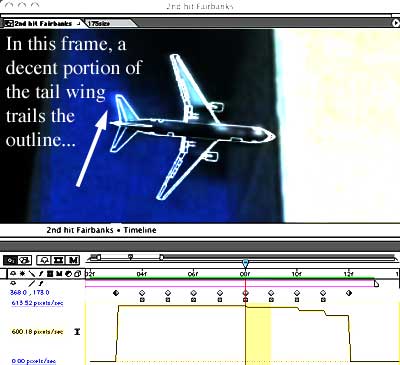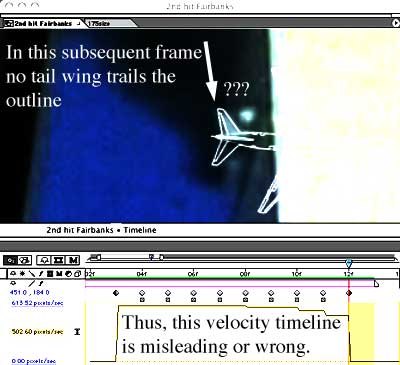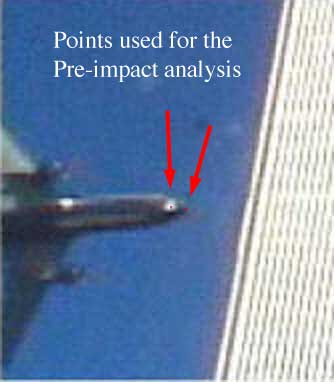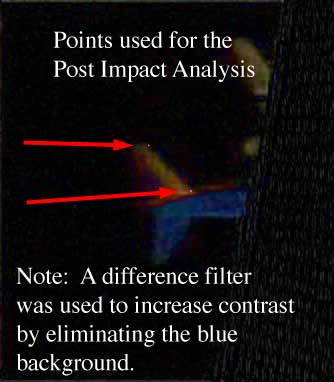
by Rick Rajter
October 26, 2006
from
NoMoreGames Website
One of the major oddities of all WTC2 videos is the apparent lack
of plane deceleration from many of the observed camera angles. The plane
seems to fly in effortlessly, but then comes to a complete stop while inside
(apparently violating conservation of momentum and energy).
To the layman, these two conservation laws mean
we should expect TWO major sources of slowdown when one object penetrates
another:
-
Energy is lost via dissipation as the
intruding object breaks and destroys the impacted area into smaller
pieces
-
Energy is transferred to the broken
pieces in the form of kinetic energy or gained velocity
A quick example: If I throw a baseball through a
window, the dissipation of energy occurs in breaking the big piece into
little pieces and velocity gained by little pieces as they fly away from the
original window location. The kinetic energy of the ball is a finite supply
used up as these two processes occur. At UA flight 175's alleged
impact speeds (estimated anywhere between 500-600 mph depending upon the
source), a 767 speeding at reasonably full weight would have some 4 billion
joules of KE (kinetic energy) for consideration.
Considering that KE energy is a finite source to draw from, a key question
arises:
"Do the videos show deceleration, or are
zero deceleration claims hogwash?"
To the best of our knowledge, Stefan Grossman
(presumably helped by Marcus Icke) did the first numbered,
reproducible frame-by-frame analysis of the flight 175 image. Using the
Fairbanks video, Grossman calculates a zero percent deceleration. In
fact, as the plane enters the building, some frames appear to show a slight
acceleration.
This is most bizarre and must be either a,
-
measurement error on Grossman's behalf
or
-
a creation error on the TV-fakery side
Reality, of course, makes acceleration
impossible. I personally think it is a measurement error from a single
frame, as this acceleration frame comes right after a deceleration frame.
Thus, if this one data point is an error, it implies an offsetting error in
an adjacent frame, given the fixed aggregate time budget.
Eric Salter followed with his own
analysis and claimed 13% deceleration based on frame-by-frame study using
one of the 2-3 Fairbanks video variants. One of the suspicious facts about
the Fairbanks video(s) is that the FBI had possession of them before they
went public.
There is a major flaw in Salter's analysis. He used an overlay or "trace" to
match the blurry 767 image to judge its speed. The problem is that it is
hard to match a wide-line trace or outline of a plane against a blurry plane
image with real consistency.
Salter is inconsistent in choosing an anchor point to locate his trace
against the video plane image. When the image is outside the building,
Salter anchors the trace at the main wings. After the plane is mostly inside
the building, Salter switches and anchors the trace at the back of the tail
wing. The trace never matches the image perfectly: outside the building
"excess" tail wing shows to the left of the outline, but inside the
building, this excess disappears.
Therefore, Salter artificially slows down his
plane trace yet the plane blur goes off ahead and Voila!
Deceleration falsely established...


For my own analysis, I decided to use the widely
known Scott Myers camera pictures, so I didn't have to worry about
compression issues, frame rates, etc. I found the highest resolution version
I could get my hands on in order to minimize loss or measurement precision.
The 15-picture spread was (allegedly) taken
using fixed 0.033 second intervals, features a nearly fixed camera angle,
and has a fairly decent contrast on key plane features. Thus, it is
perfectly suited for frame-by-frame analysis, one of the best videos in
terms of high signal-to-noise ratio.
Using photoshop, I took all 15 sections and placed them in one layered PSD
file. I then ran a series of difference filters on each neighboring pair of
frames to ensure camera positioning on the pictures had not been altered and
that they were in perfect registry (by contrast in the Salter analysis,
the WTC wall moves from frame to frame). A few pictures had to be moved left
one pixel in order to be in closer registry to frame one. No frames were
moved up, down, or right by any amount.
I used four different locations on the plane (two pre-impact positions and
two post-impact positions). Of the pre-impact positions, the fuselage glare
is the easiest to define, but the front of the nose also provides robust
numbers and a good sanity check (reduces subjectivism).
Using unaltered/un-enlarged pictures, a pixels
per second average of two pre-impact locations yield a mean of 29 pixels per
frame with a standard deviation of 0.6 with a sample size of 6.


The post-impact speeds were calculated in the
same manner, but using two different locations on the back tail.
Interestingly enough, the speeds calculated here
on the best matching data points show a 29.0 pixels per frame outside the
building with a standard deviation of 0.6 and sample size of 6 versus 29.6
inside the building with a standard deviation of 0.5 with a sample size of
5. In other words, I found 4% acceleration.
Can it be measurement error?
It is possible, but I was analyzing under 8X
magnification. But playing devil's advocate, let's look at a worst-case
scenario. Suppose I made a 1-pixel error on EVERY measurement (perhaps I
drank too much coffee and was too jittery with the mouse). That would give
me an average pre-impact speed of 30 pixels/frame and a post-impact speed of
28.6 pixels/frame.
That implies a 4.6% decrease in the average velocity. Average velocity is (Vfinal
- Vinitial)/2, so that means the actual instantaneous velocity at
the end of the interval would be an absolute maximum slowdown of 9%.
The endpoints of my calculations then are acceleration of 4% and
deceleration of 4.6%. But the assumptions underlying the latter are severe.
A more reasonable adjustment yields a middle ground estimate. The most I
would be off in favor of acceleration is 0.5 pixel per interval. If so, then
the maximum slowdown would be 2-2.5%.
A 2.5% loss of velocity means 95% of original KE (kinetic energy) is
still available. If we assume 4 billion joules is a reasonable estimate of
the energy pre-impact, then the plane would still have 3.8 billion joules
after entering.
To double-check, I blew the frames up by 8X using adobe photoshop standard
interpolation function, which gives me more precision measuring differences
in pixels between the frames. This analysis, giving generous concessions to
the deceleration crowd, gives a 3% instantaneous velocity slow down. In
short, magnification produces no difference from the un-enlarged analysis.
In summary, if there was deceleration, it was trivial.




